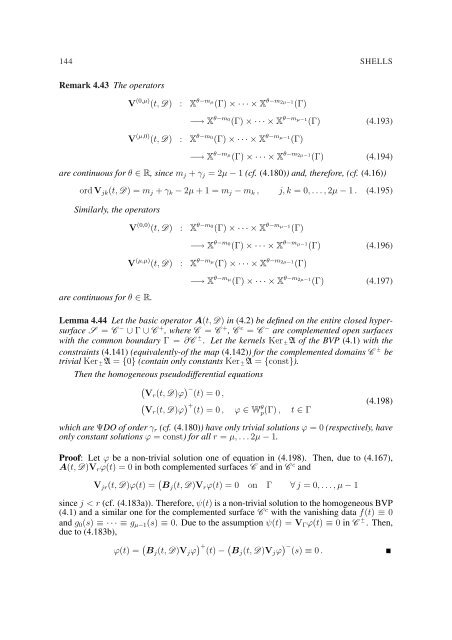EQUATIONS OF ELASTIC HYPERSURFACES
EQUATIONS OF ELASTIC HYPERSURFACES
EQUATIONS OF ELASTIC HYPERSURFACES
Create successful ePaper yourself
Turn your PDF publications into a flip-book with our unique Google optimized e-Paper software.
144 SHELLS<br />
Remark 4.43 The operators<br />
V (0,µ) (t, D) : X θ−m µ<br />
(Γ) × · · · × X θ−m 2µ−1<br />
(Γ)<br />
−→ X θ−m 0<br />
(Γ) × · · · × X θ−m µ−1<br />
(Γ) (4.193)<br />
V (µ,0) (t, D) : X θ−m 0<br />
(Γ) × · · · × X θ−m µ−1<br />
(Γ)<br />
−→ X θ−mµ (Γ) × · · · × X θ−m 2µ−1<br />
(Γ) (4.194)<br />
are continuous for θ ∈ R, since m j + γ j = 2µ − 1 (cf. (4.180)) and, therefore, (cf. (4.16))<br />
ord V jk (t, D) = m j + γ k − 2µ + 1 = m j − m k , j, k = 0, . . . , 2µ − 1 . (4.195)<br />
Similarly, the operators<br />
V (0,0) (t, D) : X θ−m 0<br />
(Γ) × · · · × X θ−m µ−1<br />
(Γ)<br />
−→ X θ−m 0<br />
(Γ) × · · · × X θ−m µ−1<br />
(Γ) (4.196)<br />
V (µ,µ) (t, D) : X θ−mµ (Γ) × · · · × X θ−m 2µ−1<br />
(Γ)<br />
are continuous for θ ∈ R.<br />
−→ X θ−mµ (Γ) × · · · × X θ−m 2µ−1<br />
(Γ) (4.197)<br />
Lemma 4.44 Let the basic operator A(t, D) in (4.2) be defined on the entire closed hypersurface<br />
S = C − ∪ Γ ∪ C + , where C = C + , C c = C − are complemented open surfaces<br />
with the common boundary Γ = ∂C −+ . Let the kernels Ker −<br />
+A of the BVP (4.1) with the<br />
constraints (4.141) (equivalently-of the map (4.142)) for the complemented domains C −+ be<br />
trivial Ker + −<br />
A = {0} (contain only constants Ker −<br />
+A = {const}).<br />
Then the homogeneous pseudodifferential equations<br />
(<br />
Vr (t, D)ϕ ) −<br />
(t) = 0 ,<br />
(<br />
Vr (t, D)ϕ ) +<br />
(t) = 0 , ϕ ∈ W<br />
θ<br />
p (Γ) , t ∈ Γ<br />
(4.198)<br />
which are ΨDO of order γ r (cf. (4.180)) have only trivial solutions ϕ = 0 (respectively, have<br />
only constant solutions ϕ = const) for all r = µ, . . . 2µ − 1.<br />
Proof: Let ϕ be a non-trivial solution one of equation in (4.198). Then, due to (4.167),<br />
A(t, D)V r ϕ(t) = 0 in both complemented surfaces C and in C c and<br />
V jr (t, D)ϕ(t) = ( B j (t, D)V r ϕ(t) = 0 on Γ ∀ j = 0, . . . , µ − 1<br />
since j < r (cf. (4.183a)). Therefore, ψ(t) is a non-trivial solution to the homogeneous BVP<br />
(4.1) and a similar one for the complemented surface C c with the vanishing data f(t) ≡ 0<br />
and g 0 (s) ≡ · · · ≡ g µ−1 (s) ≡ 0. Due to the assumption ψ(t) = V Γ ϕ(t) ≡ 0 in C −+ . Then,<br />
due to (4.183b),<br />
ϕ(t) = ( B j (t, D)V j ϕ ) +<br />
(t) −<br />
(<br />
Bj (t, D)V j ϕ ) −<br />
(s) ≡ 0 .

















